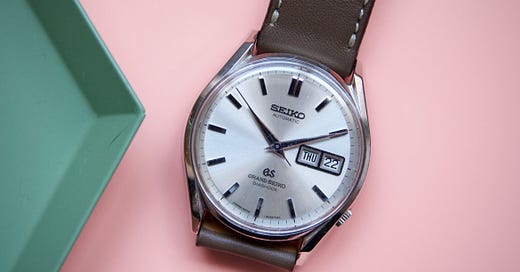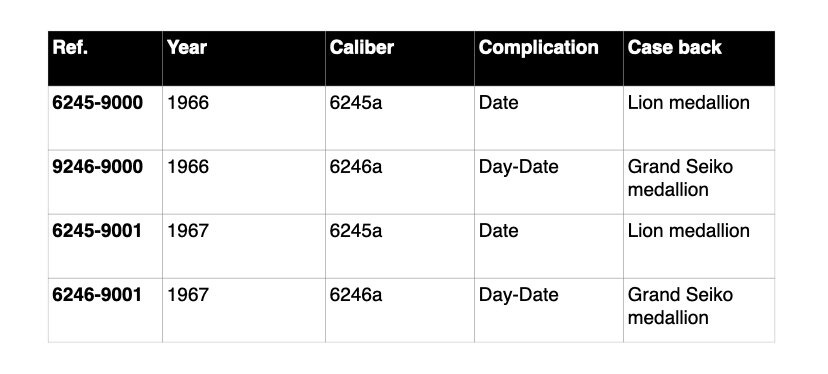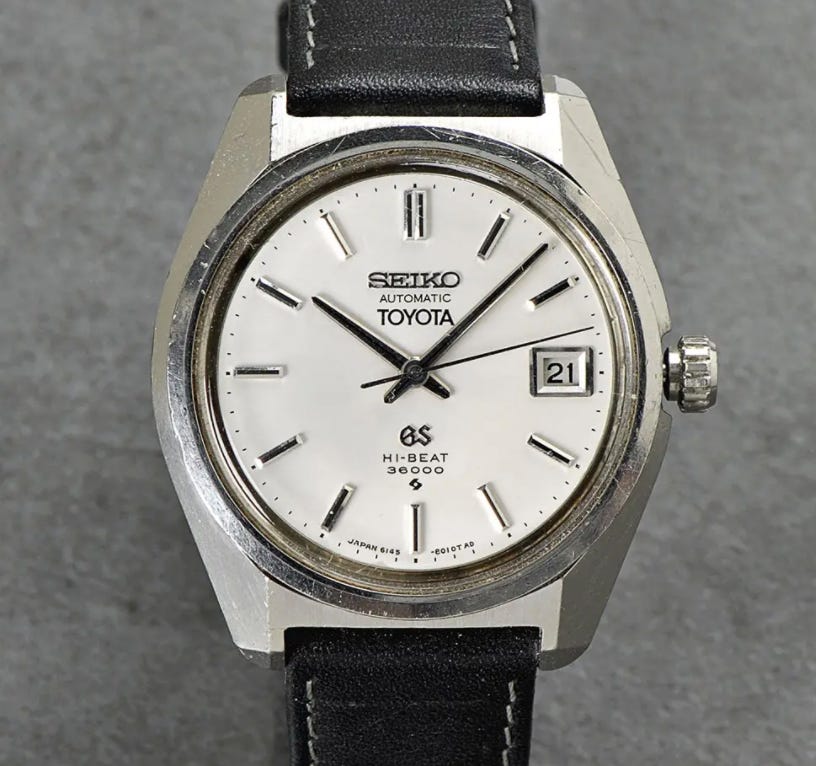Grand Seiko: On the 62GS and Toyota Dials
What's up with the Rolex Explorer, everyone's favorite watch meme bro, and lots of Grand Seiko
Grand Seiko-heavy this week, I promise I’ll give it a break for a while after this. If GS isn’t you, scroll to the bottom for the meme and Rolex portions of today’s program.
Collecting the Grand Seiko 62GS
Since writing about the “perfect Grand Seiko two-watch collection”, I’ve gotten some questions about the vintage watch featured in that piece, the Grand Seiko 62GS. The Grand Seiko references 6245 and 6246 (or “62GS”) continue to be an excellent entry point into collecting vintage Grand Seiko. Not only historically important, the 62GS just looks good — there’s a reason so much of modern Grand Seiko’s designs reference it. While some of designer Taro Tanaka’s Grammar of Design cases for Grand Seiko get a bit structural, the 62GS is not that. Recently, I saw someone refer to the 62GS as “Tanaka’s take on lyre lugs”, and that nails it. While the Western version of lyre lugs (see, e.g., Universal Geneve Polerouters, later Omega Speedmasters) are much more flowing and romantic, the 62GS’s are more architectural. Some vintage Grand Seikos begin to look a bit like a Cybertruck strapped to the wrist. The 62GS is more like … a Model S? Is that the one I can’t afford?
The 62GS was Grand Seiko’s first model to feature an automatic movement, either the caliber 6245a with date complication or 6246a with day-date complication. As I recently wrote:
The 62 series was not a wholly new caliber, but rather the result of refining Seiko’s automatic calibers dating back to the first Seikomatics featuring Seiko’s “Magic Lever” winding system. The Seikomatic “Chronometer” was available as early as 1965, with both the movement and the case shape bearing a strong resemblance to the forthcoming 62GS.
The 62GS calibers featured 35 (6245) or 39 (6246) jewels beating at 19,800 bph. Having worn one for awhile now, there’s something about the movement itself that feels substantial in a way other vintage calibers sometimes don’t. You can feel it strongly, defiantly whirring — giving the Swiss a middle finger, but in that subtle, Japanese way — like the faceted, 36mm case just isn’t enough to contain this feat of Japanese engineering.
The 62GS was produced for just a couple years, first hitting the market in 1966 and staying in production through 1967. Two different case backs were used, depending on the year of production: a lion medallion or a Grand Seiko medallion. Combined with the two different movements, this gives a total of four references for the 62GS:
6245-9000: Produced in 1966. 6245a movement, lion medallion case back.
9246-9000: Produced in 1966. 6246a movement, lion medallion case back.
9245-9001: Produced in 1967. 6245a movement, Grand Seiko medallion case back.
6246-9001: Produced in 1967. 6246a movement, Grand Seiko medallion case back.
These reference numbers are engraved into the case backs around the medallion for each model. Note that even on the later 9001 models with Grand Seiko medallion case backs, you’ll find dials printed “624x-9000” at 6 o’clock. This seems completely fine and correct — perhaps Grand Seiko printed more dials than cases and continued using them even after changing the case back reference. All models were available in both gold cap and stainless steel cases, meaning a total of eight different iterations of the 62GS can be found.
Also on the case back you’ll find a serial number engraving which can be deciphered to tell something about the watch. The first number is the last digit of the production year (6 or 7, in the case of the 62GS), the second is the month, and the final four digits are a unique production number. The months are designated 1-9 for January-September, then O, N and D for October, November, and December.
Across references, the dial remains the same: applied “Seiko Automatic” branding at 12 o’clock, with the applied GS logo at 6 o’clock, sitting above the printed Grand Seiko and Diashock. The branding, with “Seiko” prominently above Grand Seiko, illustrates how Grand Seiko was still an emerging branding concept for the Seiko company, as much an indication of its technical accuracy as an actual consumer brand. The Swiss had gotten pissed at Seiko for using the word “Chronometer” in its branding a few years prior, so Seiko went ahead and called itself Grand Seiko instead, developing an internal “Grand Seiko” accuracy standard that was more rigorous than the Swiss’ “superlative” standard.
Collecting the 62GS
As with any vintage watch, be on the lookout for over-polished cases. Because of the 62GS’s faceted case and sharp angles, cases tend to look pretty soft and lose much of their Tanaka charm after just a polish or two. Look at the faceted lugs for sharp angles. The 62GS also had a bezel-less construction which meant a special box-shaped crystal was fused directly to the case. Look for a correct crystal with sharp walls that almost form a right angle into the case.
Because the 62GS is similar in form and function to the Seikomatic “Chronometer” that was produced until at least 1965, there seem to be stories of collectors acquiring a “62GS” that’s actually a Grand Seiko dial swapped into an older Seikomatic Chronometer case. Check the serial number on the watch’s case back to make sure its production date is around 1966-67, the short time frame that seems to be correct for a 62GS.
Obviously, examples are most readily available in Japan. To get familiar with Japanese vintage dealers, follow some of the popular Japanese-language vintage watch hashtags (here and here, h/t Agaki). However, Western dealers are catching on. As of this article, a sharp, clean 62GS can still be had for a couple thousand dollars. You’ll pay a premium to buy from a Western dealer, and that’s fair enough for the convenience of not having to deal with customs (but it shouldn’t be a 2x premium).
Cap gold examples are rarer than the stainless steel version, and even more rare to find in collectible condition. But honestly, is anyone buying cap gold watches right now?
Concluding Thoughts
Listen, I know some people don’t “get” vintage Grand Seiko. The design language is decidedly different from what the Swiss were doing at the time. But it also feels like more often than not, the Japanese are simply ahead of the West when it comes to appreciating design, craftsmanship, and engineering. If there’s one accessible entry point into understanding what vintage Grand Seiko is all about, to me, the 62GS is it.
Grand Seiko 62GS Reference Table
The Grand Seiko 6145-8000 with a Toyota Dial
A couple weeks back, Hodinkee featured a vintage Grand Seiko in its much-loved “Bring A Loupe” column for the first time ever. And of course, with everything the company does nowadays, it wasn’t without some controversy. The watch in question was a GS 6145-8000 with a double-stamped “Toyota” dial. As it turns out, the watch was actually offered at Dr. Crott’s June auction before resurfacing at the dealer where Hodinkee found it for the feature (Dr. Crott sold it for EUR 2,000; the dealer where Hodinkee found it had it on offer for $5,500).
Grand Seiko expert Gerald “The Grand Seiko Guy” shared his thoughts on the watch shortly thereafter. In short, he found the watch totally legitimate, but nothing of particular historical or horological interest. The entire article is worth a read as it gives tips on identifying legit vintage Grand Seiko dials, but his conclusions are particularly noteworthy:
What makes this Toyota watch both interesting – and, arguably, not so interesting – is that the only thing on it identifying it as being produced for Toyota is the print on the dial. Apart from that – admittedly signficant – detail, the rest of the watch is identical to a regular 6145-8000….
The reason that it is worrying is that it would be relatively simple for someone to add this print to the dial of a regular watch, thus (if we are to believe the valuation placed on the watch) affording the faker the opportunity to make a considerable amount of money for very little effort indeed.
Again – our concern regarding this watch is not that it is in some way of dubious provenance … but that unscrupulous people following the watch to see if it sells will be incentivized to create a few more.
He continues by saying that there’s no way a premium of close to 200% can be logically justified by the additional line of Toyota text (premium as compared to your standard-issue 6145).
Of course, the counter presents itself: since when is anything about watch collecting logical? Some are familiar with paying something like a 2x premium for Tiffany, Serpico Y Laino, Gobbi, etc. stamps. But for Toyota on the dial? What you think I rap for, to push a f/cking Rav-4? While it’s the first known example of its kind, the Grand Seiko Guy concludes:
It’s not a particularly interesting vintage Grand Seiko. Based on our research to date, there are now 154 distinct, legitimate, vintage Grand Seiko references. One more than there was at the beginning of June 2020.
If this does sell for anywhere close to the asking price – perhaps driven in no small part by that famed “HODINKEE effect”, it does leave one question hanging in the air.
What price now for the really interesting pieces?
Image courtesy of Dr. Crott Auctioneers
Portrait of a Watch Meme Bro
It feels like watch meme accounts have had something of a moment the past couple weeks. At such a pivotal moment in the watch industry — an election year, global pandemic, controversial travel clock — watch memes have provided an honest source of critique, relief and straight-up fun.
I wanted to talk with the owner of one of my favorite meme accounts: @Brodinkee. Mr. Brodinkee has been meme’ing for more than a year now, and in that time he’s eviscerated brands, collectors, and, importantly, himself.
Q: Does the watch industry take itself too seriously? Or not seriously enough?
If I had to lean one way or the other, I’d say it takes itself a little too seriously. There are a ton of watch publications that are just out there driving the (in my opinion) unhealthy image of a “horologist lifestyle.” Sure, they give love to Swatch or Timex once in a while, but I think we forget that even a $179 Timex Q is a decent chunk of change for a lot of people. While we “collectors” focus on all the nuances of collecting, outsiders can never seem to wrap their heads around the amounts we spend and why. I find the hobby is more exclusive than it is inclusive — partly due to general snobbery and partly due to the cost of participation.
Q: How would you sum up the watch Internet in one sentence?
The best and worst sides of an ultra-passionate group of hobbyists dying to connect with others just like them.
Q: Do you have a favorite meme?
I think my favorite is one that has a screenshot from the original Legend of Zelda. In the beginning of the game, you’re given a wooden sword to guide you on your journey. It says, ‘It’s Dangerous To Go Alone! Take This!’ I swapped the sword for a SKX as a representation of how many of us began our journeys.
Check out my full conversation with the master memer.
Through the Wire
What’s up with the Rolex Explorer Ref. 14270?
I’m always in for a good watch conspiracy. A few days ago, Bark & Jack posted a curious Instagram post — “there are no Rolex Explorer 14270s on Chrono24 in the UK”. Putting aside the obvious question — is Chrono24 an accurate barometer for … anything?!? — since he’s a UK-based operation, I assumed his post was a not-so-subtle allegation that Watchfinder (also UK based) was buying up stock. Of course, two days later, Hodinkee dropped a terrific in-depth article on the model. B&J then posted a YouTube video basically outlining his conspiracy theory (just barely bleeping out “Watchfinder”). Watchfinder is Richemont-owned, so on some level, it makes sense. The only way Richemont is ever going to get anything close to that steel sports Rolex glow is by buying up stock of pre-owned Rolexes. I guess it’s also a bet that Rolex might release a new Explorer this year.
So, coincidental or conspiratorial? The Ref. 14270 has long been something of a classic — modern in most ways except for its 36mm size — making it the perfect watch for vintage enthusiasts who want something they can just bang around. And with quality vintage pieces increasingly difficult to find (the Ref. 1016 chief among them), dealers and collectors are looking at later decades.
But, the Ref. 14270 has been a modern classic because it’s a way to pick up a solid, built-to-last Rolex for a few thousand bucks. If that’s no longer true, then (to me) the Ref. 14270 loses some of its charm. The Tudor Black Bay 58 or 36 are both endlessly more interesting if they’re both going to cost a fraction of a Ref. 14270.
When I wrote about the “collectibility” of neo-vintage pieces a few months back, my case centered around the premise that these were just great watches — nothing more, nothing less — that could be snatched up at relatively reasonable prices when compared to their vintage or modern counterparts. If that’s no longer the case, then what are we doing here?
So, I’ll echo what The Grand Seiko Guy said about the 6145 “Toyota” dial above: If these Explorers do start to pop in value — perhaps driven in no small part by the “Hodinkee effect”, what price now for the really interesting pieces?
🔥 Speaking of hot watches: I had every intention of featuring this platinum Cartier Tank from The Keystone, but it sold quicker than you can say Collection Privée Cartier Paris (sold for $11k). 🧐 This Tiffany-signed IWC Yacht Club looks interesting. 🙀 If the 62GS article piqued your interest, this seems to be a sharp 6246-9001. 👸 Tudor introduces the Royal (available only in Asian markets). ⚪️ A great in-depth history of the Cartier Pasha.
In Chicago: How will history museums remember this moment?
❣️Please tap the heart or leave a comment!
—
Rescapement is a weekly newsletter about watches. If you enjoyed this edition, consider forwarding it to a friend. For all the latest, head to rescapement.com.








